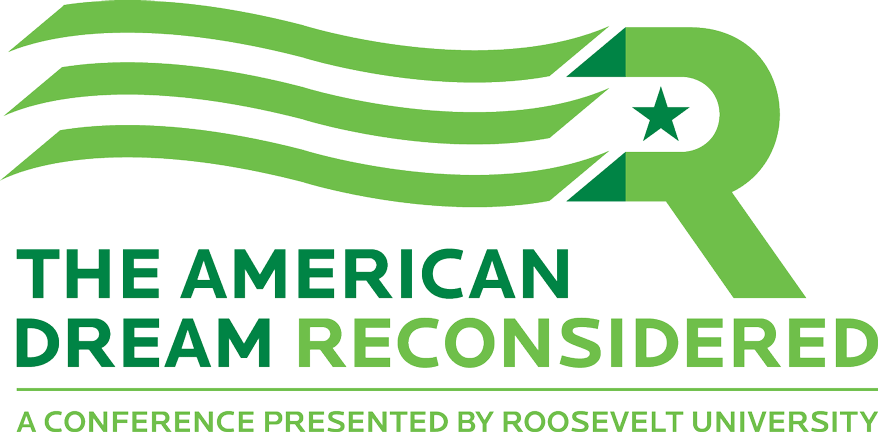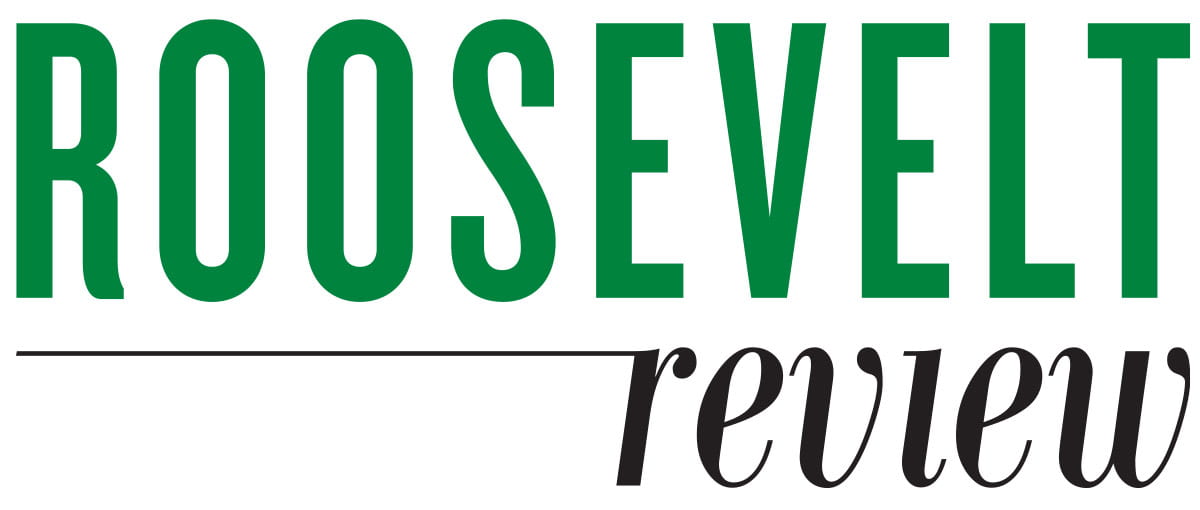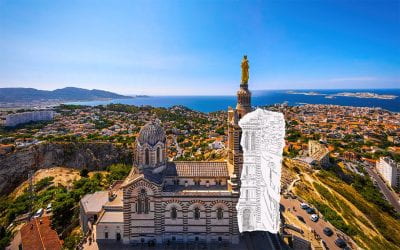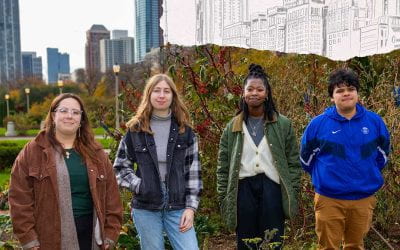The City and The American Dream
American Dream Reconsidered Comference
Race and The City
By Jared G. Fritz-McCarty

Professor of journalism John Fountain moderated “Race and the City,” which launched the conference in Roosevelt’s historic Ganz Hall.
The 2022 American Dream Reconsidered Conference opened with “Race and the City” — a discussion around the racial divisions of America’s cities, past and present. Adam Green, professor of history at the University of Chicago, and Mary Pattillo, professor of sociology and African American studies at Northwestern University, joined Roosevelt University’s John Fountain to explore practices such as segregation laws and red-lining.
Green shared that, for many historically marginalized populations, the “American Dream” is about more than tangible and recognizable elements. It is about the possibility of advancement across generations. He said, “It is about progressing from negative liberties to positive freedoms.”
Pattillo elaborated, “The American Dream for middle-class African Americans always has a smoky veneer.” For example, children of middle-class African Americans are more likely to be downward mobile than their white counterparts who are likely upward mobile. She painted a portrait of a racialized “American Dream” and the fragility of the Black middle-class.
The panel debated the stark differences of Chicago’s Black communities from the 1940s through the 60s — in comparison to today. Green and Pattillo described these neighborhoods as populated, filled-out, urban spaces full of aspiration. Dreams of opportunity were presented to young Black children, rather than their futures being assigned to them.
Fountain challenged panelists and attendees to consider possible solutions and strategies to build a brighter and perhaps less divided Chicago for future generations and our own posterity. Green replied, “We need to better appreciate all of the positive aspects that exist within our communities, especially Black communities.” Pattillo discussed embracing practices which have proven successful, such as race matching within classrooms: research shows that Black children who have Black teachers experience less exclusionary discipline and are more likely to go onto college.
Green concluded, “We must see inequality as a policy matter.” He also encouraged key institutions — like Roosevelt University — to set direction through educational programming and to operate autonomously.
Culture as a Gateway to the American Dream
By Maddie Cunningham

Regina Buccola, Professor of English, Roosevelt University
Moderated by professor of English Regina Buccola, “Culture as a Gateway to the American Dream” featured leaders of Chicago-based cultural institutions: Daniel Greene, president of the Newberry Library; Carlos Tortolero, founder and president of the National Museum of Mexican Art; and Michelle Larson, president of the Adler Planetarium.
Greene shared that the Newberry Library strives for everyone to feel welcome and stressed the Library’s ease of approachability. He explained that in a time when information — true and false — comes from so many sources, libraries should be trusted but are expected to prove “How do we know that’s true?”
Larson raised the question of what public goods are and how funding should be allocated to them. She used Adler Planetarium as an example of a public resource that relies heavily on funding to support the pursuit and sharing of knowledge with the community — especially with schoolchildren. She believes that institutions should bring education to the community instead of requiring them to come to a physical space. Because “we all share the sky,” learning and observation can be done wherever you can use a telescope.
Tortelero urged museums and other cultural institutions to discuss difficult topics, saying they can use the public’s trust in them to call attention to racism. He believes in supporting the interests and needs of the communities in which the museum resides — rejecting the notion that museums should even be thought of as physical structures at all, but instead vehicles for the public to use as necessary.
Overall, the panelists expressed the importance of engagement and supporting cultural institutions in the face of challenges to democracy, emphasizing that they, too, would do their part in connecting with the local community.
Herb H. Franks Endowed Seminar in Political Science:
A New Deal for the City
By Salma Mardi

Bradford Hunt, Professor of History, Loyola University Chicago
“A New Deal for the City” offered unique perspectives, all stemming from the diverse experiences of its panelists: Larry Bennett, professor emeritus of DePaul University; Carlos Ramirez-Rosa, 35th ward alderman; and Lisa Yun Lee, executive director of the National Public Housing Museum. This discussion about the American Dream and how it relates to America’s cities was led by Bradford Hunt, professor of history at Loyola University.
Collectively, the panel proposed that revitalization of the New American Dream (NAD) requires us to consider what has and has not worked in the past. Panelists also stressed the importance of equity being at the center of this approach. The panel explored security, freedoms, police reform, accessibility and housing. Yun Lee applied her expertise on housing and connected it to the NAD — exploring how home ownership has been misconstrued within the American Dream as a qualifier of success.
The panelists reiterated the importance of voting, but reminded the audience that it is only one factor in the entire scheme of things. They offered an interesting analogy: voting is like brushing your teeth. You have to do it, but it is not the only thing that’s important for your health. The panel concluded with a reminder of the importance of community in the progression of the New American Dream.
Is the American Dream Sustainable?
By Cesar Gonzalez

Mike Bryson, Professor of Sustainability Studies, Roosevelt University
Mike Bryson, professor of sustainability studies, and Andrew Trees, visiting assistant professor of political science, partnered together to host “Is the American Dream Sustainable?” They were joined by Roosevelt alumni Yesenia Balcazar and Dan Lyvers, as well as current student Kiera Carpenter.
Panelists discussed sustainability through the lens of personal experiences. Lyvers aspires to build a better world for his family to live in — in light of humans slowly killing the planet we inhabit. Balcazar, who grew up on the southeast side of Chicago, spoke about living in a community predominately overshadowed by industries associated with health concerns of minority individuals. She attributes her awareness of injustices in urban planning to her Roosevelt education. Both Lyvers and Balcazar agree that much of what’s “hip” is influenced by money: if city planners invest time, resources and money into building a self-sustaining neighborhood, it attracts people to reside there.
The panel also explored the ideal sustainable city — a community that helps everyone, has equitable access to resources and embraces shared decision-making among community members. The ideal city’s current choices do not jeopardize future generations. Carpenter believes environmental justice is attainable in Chicago by educating people about the environmental issues in their communities and promoting leaders to act on those issues. Two current and pressing issues for minority neighborhoods, also labor projects, are food insecurity and air pollution.
Balcazar opined that the American Dream is more than a large home and white picket fence. Instead, it should be about clean water, clean air and no lead pipelines. Sustainability is about approach, inclusion and balance, and it should benefit all — regardless of sex, age, race, ethnicity, gender identity and class. Lyvers added, “The American Dream has allowed us to trample over Mother Nature and expect no consequences. We have already gone down that road and need to be mindful of her wrath.”
Matthew Freeman Lecture: “The Blood, The Brain, The Barriers”
By Khaliya Jackson
Sponsored by the Mansfield Institute for Social Justice and Transformation and the College of Science, Health, and Pharmacy

Sadhana Jackson, MD, National Institute of Health
This year’s Matthew Freeman lecturer was Dr. Sadhana Jackson, a pediatrician and pediatric hematologist/oncologist, who is an investigator in the Developmental Therapeutics and Pharmacology Unit at the National Institutes of Health. Jackson spoke to students about the causes behind an expected physician shortage by 2035 and offered tips to empower students to find beneficial mentorships for their own careers. Through an introspective analysis of her own experience, including her own struggles with financial hardships, she provided context and clarity for students pursuing careers in the medical profession. She credits her community for supporting and guiding her through the more troubling parts of her journey and spoke proudly about the time and intention required to invest in a community. She credits her time at the NIH for her understanding of the difference between mentorship and sponsorship in terms of one’s personal development.
As Dr. Jackson stated, “A mentor is a guide, while a sponsor speaks your name in rooms you have yet to enter.” Dr. Jackson and seven other coworkers recently created the UNITE initiative’s The Power of an Inclusive Workplace Recognition Project to “diversify the portraiture within NIH buildings” and then drafted a statement to the president of NIH calling for increased diversity and inclusion efforts at the institutes.
CCPA Performance: Discovering Our Voices in Chicago
By Lydia Groezinger
The Chicago College of Performing Arts concluded this year’s conference with Discovering Our Voices in Chicago — a concert celebrating the history and uniqueness of Chicago’s artistic migrants, immigrants and émigrés. The concert featured students who asked both provocative and personal questions about identity through their artistry.
The concert opened with baritone Charles Butler singing “Songs to the Dark Virgin” by Florence Price. Price was the first African-American woman to be recognized as a symphonic composer. Her composition career expanded when she came to Chicago to flee segregation in the South. While in Chicago, she enrolled in various colleges, including Roosevelt’s former Chicago Musical College.
Next was a provocative exploration of songs from the Great American Songbook, a collection of popular songs and jazz standards deemed the most influential of the early 20th century. Five songs were performed: “Something to Live For;” “Honeysuckle Rose;” “Perfidia;” “Crazy Rhythm;” and “Just for a Thrill.” Performers — Jared Brown, Makenzy Jenkins, Cris Moreno, Maddie Gallagher and Fia Hunter — each questioned the American Songbook in unique ways and confronted the biases students of color face in conservatories.
The Hard Bop Combo then played Thelonious Monk’s “Bemsha Swing.” Monk, a jazz pianist and composer most known for his unique improvisational style, never lived or studied in Chicago, but he did often visit Roosevelt University to guide students towards finding their artistic voices.
Discovering Our Voices in Chicago concluded with a joint performance of Fred Fisher’s “Chicago,” which exemplified how each unique voice becomes a part of the city of Chicago.
More in this section
unexcused absence
Some of life’s most important lessons cannot be taught inside the four walls of a classroom. Matthew Beardmore’s travel has forced him to reassess how he thinks about work, family, politics, injustice and many other issues. He’s no longer tied to the beliefs of where he grew up.
traveling while home: self-discovery through the local
How can you make the long trip home if you don’t actually leave there? A partnership between Roosevelt University’s Honors Program and Chicago Architecture Center asks students to experience space and place as sites for action—not simply places we passively inhabit.
creating a new travel niche while wandering the globe
In early 2011, Sahara Rose De Vore bought a one-way ticket to Costa Rica. Over the next 10 years, she explored 84 countries. The self-discovery she experienced inspired her to launch two successful businesses—both helping others discover the benefits of travel.



